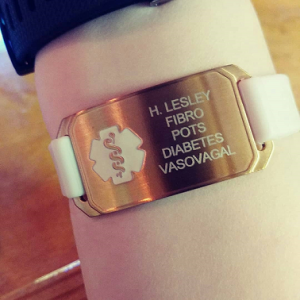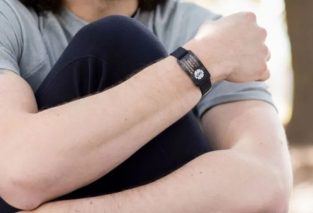Why use a medical ID and not just a wallet card, mobile app or a MyChart account? Let’s get this question out of the way first.
You look at your medical history, medicines and conditions and wonder – how on earth can I fit all of this onto a medical ID bracelet?
If you are concerned about prompt and effective care in an emergency, you should absolutely make the effort to distill it down to the vital details that should be seen first in an emergency. Your medical ID, worn around your wrist or neck, will likely be the first thing the EMS see when time is of the essence.
 We are often separated from our phones in an accident.
We are often separated from our phones in an accident.
Then there is always the question of battery life, wifi, user IDs and passwords to deal with. EMS may not be able to look into your wallet for an ID card.
Nothing is as dependable as an engraved medical ID.
A medical ID is the gold standard and can truly be a life saver.
Take it from the CDC – “Help others help you…wear a medical ID bracelet or necklace”.
Have you used all the available space?
Engraving space is often a limiting factor in what you can communicate on your ID.
Remember when shopping for an ID that there are variations in the amount of available engraving space from one ID to another.
Some offer front and back engraving, some offer only single side engraving. Some may have only 3 lines on a side, others up to 8 lines of engraving.
So don’t forget to consider the full extent of ID bracelets or necklaces as pertains to maximizing available engraving characters and sides.
Prioritize
In most cases this question can be answered with a simple “What is the most important medical information that should be known about me – or your loved one – in a medical emergency should I be unconscious or unable to speak for myself?”
Let that be your primary guide. For many, it really is that simple.
Your name, followed by your most chronic medical conditions, allergies or emergency contacts.
Unfortunately, a medical ID bracelet or necklace is limited by space. You’ll need to decide what are the MOST important details to engrave.
Use Common Abbreviations
If space remains an issue, abbreviations are another way to save space.
Some examples: PCN = Penicillin, CHF = Congestive Heart Failure, T2D = Type 2 Diabetes, CAD = Coronary Artery Disease, HTN = Hypertension. There are online references for medical abbreviations.
If possible, do not go overboard with abbreviations when you can spell out your conditions or medications.
You’re In Control
In summary, deciding what to engrave on a medical ID is not one size fits all. Use common sense, get help from a doctor, pharmacist or nurse.
Do some self-education by using credible websites such as the CDC, Mayo Clinic, Cleveland Clinic, Johns Hopkins, Kaiser Permanente and others.
When doing online research the source of the information is of utmost importance. Those listed here are all highly reliable and provide search tools to learn basics about most health-related conditions. They all present information in a format that is digestible for all of us non-medical professionals.
On these sites you will find the value of a medical ID bracelet or necklace cited for many medical issues. However, they will not tell you what to engrave on your medical ID. That is because we are all individuals – medically and otherwise – and for that reason, it comes down to being an individual decision.
Shop Medical IDs
Read our Engraving Tips Article






